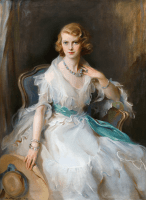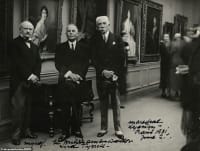We are grateful to Katherine Field for her kind assistance when writing this catalogue note.
The subject of this alluring portrait is The Hon. Mrs Philip Leyland Kindersley (née Oonagh Guinness), later Lady Oranmore and Browne, a famous socialite, art collector and society hostess.
Oonagh was the daughter of Ernest Guinness, whose father Edward Guinness, 1st Earl of Iveagh, was the head of Guinness brewery and the wealthiest man in Ireland. Oonagh and her two sisters were famously dubbed the ‘golden Guinness girls’ on account of their blonde hair, bright blue eyes and startlingly good looks.
Two years before this work was painted, Oonagh married The Hon. Philip Kindersley, second son of the banker Robert Kindersley, 1st Baron Kindersley, and together they had two children. On her marriage, Oonagh was given Luggala, a large estate in Co. Wicklow, where she moved permanently following her divorce from second husband Dominick Browne, 4th Baron Oranmore and Browne, in 1950. The...
We are grateful to Katherine Field for her kind assistance when writing this catalogue note.
The subject of this alluring portrait is The Hon. Mrs Philip Leyland Kindersley (née Oonagh Guinness), later Lady Oranmore and Browne, a famous socialite, art collector and society hostess.
Oonagh was the daughter of Ernest Guinness, whose father Edward Guinness, 1st Earl of Iveagh, was the head of Guinness brewery and the wealthiest man in Ireland. Oonagh and her two sisters were famously dubbed the ‘golden Guinness girls’ on account of their blonde hair, bright blue eyes and startlingly good looks.
Two years before this work was painted, Oonagh married The Hon. Philip Kindersley, second son of the banker Robert Kindersley, 1st Baron Kindersley, and together they had two children. On her marriage, Oonagh was given Luggala, a large estate in Co. Wicklow, where she moved permanently following her divorce from second husband Dominick Browne, 4th Baron Oranmore and Browne, in 1950. The estate became a social hub for high society in Ireland: ‘Nobody could keep away: Dublin intelligentsia, literati, painters, actors, scholars, hangers-on, toffs, punters, poets, social hang-gliders were attracted to Luggala as to nowhere else in Ireland — perhaps even in Europe, from where many would come. And the still centre of this exultant, exuberant chaos was Oonagh.’[1] Oonagh had three children from her second marriage, including Garech Browne, a celebrated patron of Irish arts who inherited Luggala on Oonagh’s death.
By the time this work was painted, Philip Alexius de László had solidified his reputation as one of the leading society portrait painters in Europe with scores of aristocratic and Royal patrons. Earlier in 1900, de László had married Lucy Guinness, a relation of Oonagh’s from another branch of the family, and it was perhaps through this contact that the present work came about.
Described by the artist himself as ‘…one of my very best portraits…’, this work was exhibited soon after it was painted at the Charpentier Gallery, Paris in 1931. It was one of the most important solo exhibitions of de László’s career and showcased his best works borrowed from private collections.
Sittings for the portrait began on 9 April 1931 and de László noted in his diary that he made an initial drawing of the composition. Oonagh’s dressmaker was also present and de László “explained the simple early Victorian dress I want for the portrait”.[2] It was not uncommon for de László to request that a particular dress be made for a portrait sitting – he generally preferred historical styles of dress so that his portraits would not look out of place when hung alongside the work of past masters such as Reynolds, Gainsborough and Lawrence.[3] The frame was provided by de László’s framemaker Emile Remy who was known for supplying high-quality frames for artists and dealers such as Sir John Lavery and Joseph Duveen.[4]
Oonagh sat eight times for the portrait - a number reserved for pictures de László felt would be his best work - and it was completed during a full-day sitting on 7 May.[5] After it had returned from the Paris exhibition, Oonagh wrote to thank the artist and invite him and Lucy to visit her at 11 Rutland Gate to the portrait hung: “My picture has been admired by every one. Most people say it is the loveliest picture they have ever seen.”[6]
The present portrait hung at Luggala until Oonagh’s death in 1995. It was subsequently sold to a private American collector and was recently repatriated.
[1] Luke, M. (1995) ‘Obituary: Oonagh Oranmore’, The Independent. 11 August 1995.
[2] László, P. D. (1931) Diary entry, 9 April 1931.
[3] Field, K. (2020). The Honourable Mrs Philip Leyland Kindersley, née Oonagh Guinness. [online]. Available at: https://www.deLászló catalogueraisonne.com/catalogue/the-catalogue/oranmore-and-browne-lady-nee-oonagh-guinness-other-married-name-the-honourable-mrs-philip-leyland-kindersley-5867/search/keywords:oonagh--sorting:alphabetical. (Accessed 5 October 2021).
[4] Field, K. (2020). The Honourable Mrs Philip Leyland Kindersley, née Oonagh Guinness. [online]. Available at: https://www.deLászló catalogueraisonne.com/catalogue/the-catalogue/oranmore-and-browne-lady-nee-oonagh-guinness-other-married-name-the-honourable-mrs-philip-leyland-kindersley-5867/search/keywords:oonagh--sorting:alphabetical. (Accessed 5 October 2021).
[5] Field, K. (2020). The Honourable Mrs Philip Leyland Kindersley, née Oonagh Guinness. [online]. Available at: https://www.deLászló catalogueraisonne.com/catalogue/the-catalogue/oranmore-and-browne-lady-nee-oonagh-guinness-other-married-name-the-honourable-mrs-philip-leyland-kindersley-5867/search/keywords:oonagh--sorting:alphabetical. (Accessed 5 October 2021).
[6] DLA073-0127.





